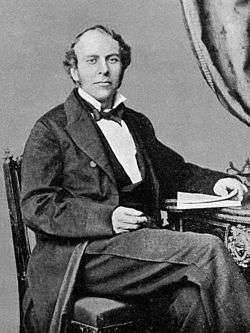Joseph Toynbee
Joseph Toynbee FRS (30 December 1815 – 7 July 1866) was an English Otologist, whose career was dedicated to pathological and anatomical studies of the ear.
Joseph Toynbee | |
|---|---|
 Joseph Toynbee, published in 1910 | |
| Born | 30 December 1815 Heckington, Lincolnshire |
| Died | 7 July 1866 (aged 50) |
| Nationality | British |
| Known for | pathological and anatomical studies of the ear |
| Scientific career | |
| Fields | Otologist |
| Influenced | Arnold Toynbee |
Personal life
Joseph Toynbee was born in Heckington, Lincolnshire in 1815. He was the second son of fifteen children of the wealthy land owner and farmer George Toynbee (1783–1865). His first wife and mother of Joseph was Elizabeth Cullen (1785–1820[1]). After several years of private teaching, he attended King's Lynn Grammar School in Norfolk. At the age of seventeen he studied medicine. His first experience in medicine came when he was apprenticed to William Wade of the Westminster General Dispensary in Gerrard Street in Soho London. He studied anatomy under George Derby Dermott (1802–1847) at Hunterian Medical School at the Great Windmill Street, and later gained a reputation as a prosector. He was married, in August 1846, to Harriet (née Holmes), daughter of Nathaniel Holmes. They had nine children together, including economic historian Arnold Toynbee (1852–1883), and the bacteriologist Grace Frankland (née Toynbee).[2]
Another son, Harry Valpy Toynbee (1861–1941), was the father of universal historian Arnold J. Toynbee, and archaeologist and art historian Jocelyn Toynbee.
He died in July 1866 while conducting experiments with prussic acid and chloroform as a remedy for tinnitus. Either one of these substances or their combination are responsible for his death.[3] He was buried at St Mary's Church, Wimbledon.
Career
He performed studies on the functionality of the Eustachian tube and of the tympanic membrane [3] and tried to restore attempts, the tympanoplasty. When St. Mary’s Hospital was founded in Paddington, he a became an aural surgeon and a lecturer on ear diseases — his course of clinical lectures being published in 1855 and 1866.[3] During this time period he composed two major works: "A Descriptive Catalogue of Preparations Illustrative of the Diseases of the Ear" (1857), and "The Diseases of the Ear: Their Nature, Diagnosis and Treatment" (1860). From his many dissections of "deaf ears", he studied ankylosis of the stapes.[3]

He was elected a Fellow of the Royal Society in March 1842.[4]
Austrian otologist Adam Politzer (1835–1920) penned biographies in French (1905) and German (1914) honoring Toynbee, whom Politzer regarded as a major influence.
Works
- On the structure of the membrana tympani in the human ear. Richard Taylor, London 1851
- On the use of an artificial membrana tympani in cases of deafness : dependent upon perforation or destruction of the natural organ. J. Churchill, London 1857
- A Descriptive Catalogue of Preparations illustrative of the Diseases of the Ear in the Museum of Joseph Toynbee. J. Churchill, London 1857
- The Diseases of the Ear: Their Nature, Diagnosis, and Treatment. Blanchard and Lea, 1860
- Hints on the Formation of Local Museums. Robert Hardwicke, 1863
References
- "Elizabeth, wife of George Toynbee junior, Farmer. Abode: Heckington Fen. Buried March 29th 1820. Age 35." HECKINGTON PAR/1/7: Burials 1813 - 1864: No.191, p.24. Lincolnshire Archives.Retrieved 2 March 2020.
- Cohen, S. (2004-09-23). Frankland [née Toynbee], Grace Coleridge (1858–1946), bacteriologist. Oxford Dictionary of National Biography. Retrieved 30 Jan. 2018, see link
- Hawkins J.E. (2004). "Sketches of Otohistory, Part 2: Origins of Otology in the British Isles: Wilde and Toynbee". Audiol Neurootol. 9: 129–134. doi:10.1159/000077263. Archived from the original (PDF) on 28 April 2010.
- "Lists of Royal Society Fellows 1660–2007" (PDF). royalsociety.org. London: The Royal Society. Retrieved 18 July 2010.
Further reading
- Betlejewski, Stanisław; Betlejewski, Andrzej (August 2009). "Joseph Toynbee—otologist, scientist, philanthropist". Otolaryngologia polska. the Polish otolaryngology (in Polish). Poland. 63 (2): 199–203. doi:10.1016/S0030-6657(09)70106-4. ISSN 0030-6657. PMID 19681496.
External links
| Wikisource has the text of the 1885–1900 Dictionary of National Biography's article about Toynbee, Joseph. |
| Wikimedia Commons has media related to Joseph Toynbee. |
- Sketches of Otohistory; Origins of Otology in the British Isles: Wilde and Toynbee by Joseph E Hawkins
- Adam Politzer studies by Dr. Albert Mudry
- New General Catalog of Old Books and Authors at the Wayback Machine (archived 28 April 2010)
Toynbee genealogy
Beginning with Joseph, the Toynbees have been prominent in British intellectual society for several generations (note that this diagram is not a comprehensive Toynbee family tree):
| Joseph Toynbee Pioneering otolaryngologist | Harriet Holmes | ||||||||||||||||||||||||||||||||||||
| Arnold Toynbee Economic historian | Harry Valpy Toynbee | Gilbert Murray Classicist and public intellectual | Lady Mary Howard | ||||||||||||||||||||||||||||||||||
| Arnold J. Toynbee Universal historian | Rosalind Murray 1890–1967 | ||||||||||||||||||||||||||||||||||||
| Antony Harry Toynbee 1914–39 | Philip Toynbee Writer and journalist | Anne Powell | Lawrence Toynbee b. 1922 | ||||||||||||||||||||||||||||||||||
| Josephine Toynbee | Polly Toynbee Journalist | ||||||||||||||||||||||||||||||||||||